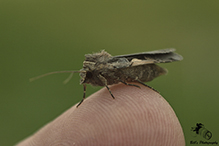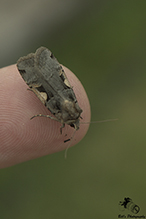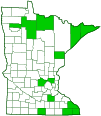Greater black-letter dart
(Xestia dolosa)
Conservation • Description • Habitat • Ecology • Distribution • Taxonomy
|
|
||||||||||||||||||
Description |
Greater black-letter dart is a common, medium-sized moth. Adults are ¾″ to 13 ⁄16″ (20 mm to 21 mm) in length, with a wingspan of 1 9 ⁄16″. The forewing is long and moderately narrow. On the male it is reddish-brown, on the female it is bluish-gray. The base of the wing on both sexes is purplish-gray. The line separating the basal area and median area (antemedial line) is scalloped. In the upper median area, a large, triangular, straw-colored spot (orbicular spot) widens toward the leading edge of the wing. In the lower median area, a large, kidney-shaped spot (reniform spot) is burnt orange to purplish-gray with a thin black outline. There are also conspicuous dark spots, including a black basal dash, a median bar, and a subapical patch. The terminal area of the wing is noticeably darker on males, much less so on females. The hindwing on the male is whitish-gray at the base, becoming darker gray as it approaches the margin, with slightly darker veins. The hindwing of the female is similar but darker. The head and thorax are same color as the forewing. The thin line on the thorax just behind the head (collar) is pale brownish-yellow. The antennae are slender and thread-like. The caterpillars are smooth and about 1½″ in length. They are usually brown but are sometimes green or gray. Three stripes on the upper (dorsal) side of the abdomen (the middorsal and subdorsal stripes) are thin and inconspicuous. On gray and brown caterpillars there are usually dark slanting spots on each abdominal segment in the subdorsal area. A pale horizontal stripe (subspiracular stripe) on each side of the abdomen dips below the breathing opening (spiracle) on the eighth abdominal segment (A8) and continues onto the leg-like appendage (proleg) on A10. The spiracles are white to tan with a thin black outline. The ground color of the abdomen is darker above the subspiracular stripe, paler below. Each proleg has a number of minute hooklets (crochets) that allow the caterpillar to hold onto vegetation. The proleg on A3 has about 25 crochets. A dark bar on each side of the head runs over the top of the head (vertex) and continues to the to the side of the triangle (frons). |
Size |
Total length: ¾″ to 13 ⁄16″ Wingspan: 1 9 ⁄16″ |
Similar Species |
Setaceous Hebrew character (Xestia c-nigrum) is smaller, ⅝″to ¾″ (15 mm to 19 mm). The antemedial line is straight. The caterpillar is virtually inseparable and is best reared to adulthood for identification. |
Habitat |
Forests and woodlands |
Ecology |
Season |
Two generations, May to September |
Behavior |
The caterpillars burrow into the ground where they spend the day. They come out at night to feed on vegetation within a meter of the ground. |
Life Cycle |
They overwinter as late stage (instar) larvae. |
Larva Hosts |
Grasses, forbs, and low-growing woody plants; and apple, maple, currant, and pear. Possibly also agricultural crops, including barley, clover, corn, and tobacco. |
Adult Food |
Flower nectar |
Distribution |
||
|
Sources 21, 22, 24, 27, 29, 30, 71, 75, 82, 83. Biodiversity occurrence data published by: Minnesota Biodiversity Atlas (accessed through the Minnesota Biodiversity Atlas Portal, bellatlas.umn.edu, 8/16/2025). |
|
| 8/16/2025 | ||
Occurrence |
||
|
||
Taxonomy |
|
Order |
|
Superfamily |
Noctuoidea (Owlet Moths and Allies) |
Family |
Noctuidae (cutworm moths and allies) |
Subfamily |
|
Tribe |
Noctuini |
Subtribe |
Noctuina |
Genus |
Xestia |
Subgenus |
Megasema |
In 1980, setaceous Hebrew character (Xestia c-nigrum) was separated from greater black-letter dart (Xestia dolosa). Before that, they were considered one species. In 1998, J. Donald Lafontaine suggested that the two species are ecologically separated, with X. dolosa inhabiting moderately moist (mesic) woodlands, and X. c-nigrum inhabiting disturbed and grassy landscapes, agricultural crops, fields, and gardens. According to Lafontaine, only X. c-nigrum is an agricultural pest. |
|
Subordinate Taxa |
|
|
|
Synonyms |
|
|
|
Common Names |
|
greater black-letter dart greater black-lettered dart spotted cutworm woodland spotted cutworm |
|
Glossary
Antemedial (AM) line
A thin line separating the basal area and the median area of the forewing of Lepidoptera.
Collar
In grasses: The area on the back of a grass leaf at the junction of the sheath and the blade. On moths: the upperside of the prothorax.
Frons
The upper front part of an insect’s face, roughly corresponding to the forehead.
Instar
The developmental stage of arthropods between each molt; in insects, the developmental stage of the larvae or nymph.
Orbicular spot
A circular spot or outline in the upper median area near the antemedial line on the forewing of many moths.
Proleg
A fleshy structure on the abdomen of some insect larvae that functions as a leg, but lacks the five segments of a true insect leg.
Reniform spot
A kidney-shaped spot or outline in the lower median area near the PM line on the forewing of many moths.
Spiracle
A small opening on the surface of an insect or arachnid through which it breathes.
Visitor Photos |
||
Share your photo of this insect. |
||
This button not working for you? |
||
Bill Reynolds |
||
 |
 |
|
MinnesotaSeasons.com Photos |
||
|
||
|

Slideshows |
|

Visitor Videos |
||
Share your video of this insect. |
||
This button not working for you? |
||
|
Other Videos |
||
Greater Black-letter Dart Moth (Noctuidae: Xestia dolosa) Lateral View |
About
Published on Sep 23, 2011 Photographed at the Turtle River State Park, North Dakota (23 September 2011). |
Greater Black-letter Dart Moth (Noctuidae: Xestia dolosa) Dorsal View |
About
Published on Aug 16, 2011 Photographed at the Turtle River State Park, North Dakota (16 August 2011). |
Xestia c-nigrum/dolosa 09-11-16 |
About
Published on Sep 12, 2016 |

Created: 9/4/2017 Last Updated: © MinnesotaSeasons.com. All rights reserved. |


